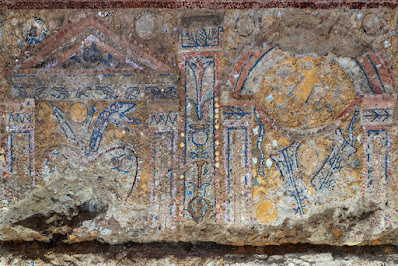Archaeologists from the Colosseum Archaeological Park in Rome have uncovered a Republic-era mosaic at a house being excavated on the Palatine Hill in the city, according to a press release issued by the Italian Ministry of Culture on 12 December 2023. The house is believed to have belonged to an important Roman family of the period, and was built between in several phases between the middle of the second century BC and the early years of the first century BC, and is spread over several terraced on the side of the hill.
The mural was found within a large specus aestivus (banqueting hall) designed to resemble a cave or grotto, with a number of water features fed by a system of lead pipes. The mural is in a 'rustic' style, made using shells, glass and ceramic tiles, and pieces of different types of rock, unlike the more familiar mosaics of the Imperial-era, which are made entirely of small tiles (tesserae).
The mural is split into four panels, separated by decorative pilasters (pillars set into a wall), and depicts a series of military scenes, including stacks of weapons topped with carnyx trumpets (which were associated with Celtic peoples, possibly implying the owner of the house had been involved in a victory over a Celtic group), several ships, and a city overlooking the sea (possibly indicating further military, and naval, victories).
The owners of the house were clearly important figures in the late Roman Republic, wealthy enough to build a large and luxurious residence in a prestigious part of the city, and also seem to have been involved in successful military campaigns. However, this prominence may have been short-lived, as much of the Palatine Hill was re-purposed to form a series of grain warehouses during the Augustine Age, to the presumed detriment of owners of homes on the hill.
See also...
Follow Sciency Thoughts on Facebook.
Follow Sciency Thoughts on Twitter.









